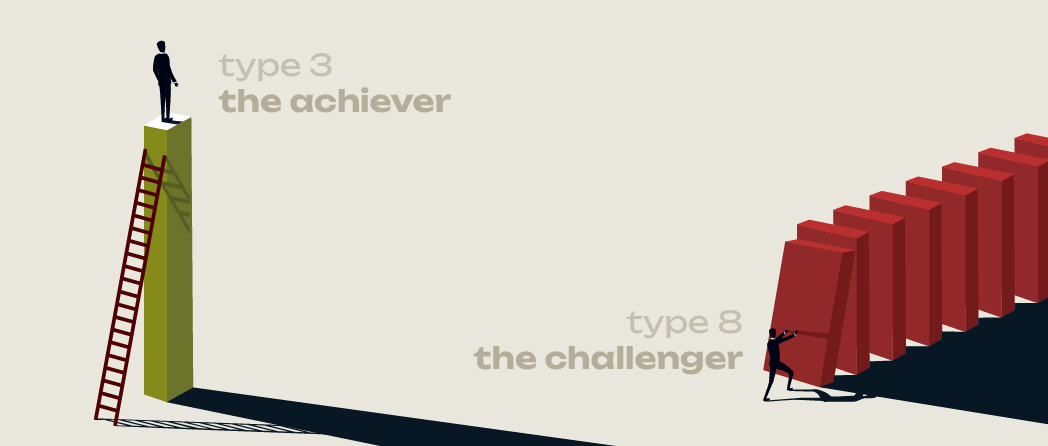While change is a constant in life, everyone experiences it differently. You might be devastated going through the end of a relationship, or ecstatic from the news of a job promotion. While for others, the break-up could feel liberating, and the job promotion might make them panic.
Some people embrace all kinds of change, while others prefer the comfort of familiarity and routine. How can you navigate change most effectively, given your own tendencies?
The Enneagram model of personality can give great insights into how you respond to change and uncertainty. The better you understand yourself, the more likely you are to know how to celebrate positive change, deal with unforeseen challenges, and avoid impulsive decision-making.
Read on to discover the different ways in which the nine Enneagram Types respond to and handle change.
Understanding change and how your Enneagram Type can help
The effects of change are often felt on many different levels. For example, if you move to a new country or city, you experience many immediate changes: adapting to new surroundings, meeting new people, etc. Becoming more familiar with your new home over time also introduces long-term change. And while the change itself is external, i.e., being in a new place physically, you change on the inside as you adapt. The way all this affects you is often influenced by your personality type, making the Enneagram a useful tool to help navigate the course of change.
In this article, you’ll find the Enneagram types grouped into four representations of how we commonly respond to change. Each representation outlines typical behaviors, triggers, and patterns so you can better understand yourself. You’ll also find practical tips to navigate new circumstances with confidence and growth.
The Adapters: Types 7 and 4
Enthusiasts and Individualists are both types who tend to adapt well to new situations, often embracing change. Flexible and spontaneous, they view change as an opportunity rather than a roadblock or challenge.
Where Adapters can run into difficulty with change, however, is if they rush into things or forget their own needs. Enthusiasts may leap in too quickly, driven by excitement and the thrill of new experiences, while Individualists can approach change with headstrong determination that emphasizes their personal identity, sometimes overlooking practical details in the process.
Adapters can benefit from slowing down when an opportunity for change comes along. Pausing to review their decisions and grounding themselves before moving ahead can help ensure a more balanced and well-thought-out approach to change.

The Strategists: Types 1, 5, and 6
Reformers, Investigators, and Loyalists are all great at planning, analyzing, and preparing for what might come next. Methodical and deliberate, they prefer control over uncertainty and possess considerable foresight. Their ability to organize and assess risks helps them make decisions that pay off in the long run.
What strategists can suffer from in the face of change is a tendency to over-analyze a decision until they are unable to make a choice at all. They might experience stress when facing unpredictable challenges. Not all change can be planned for, meaning strategists risk being negatively impacted by it.
To combat their fear of unpredictable change, strategists can try experimenting with it in small, manageable ways. Making small adjustments to their routine can help strategists practice handling unexpected changes by reducing the number of “reliable” moments in their day.
Flexibility is an important skill for strategists to learn when it comes to adapting to change. As they have a more structured approach to life than other types, stepping back and accepting the things that can’t be changed, while remaining focused on the present, can enhance their adaptability while still using their natural strengths to plan effectively.

The Supporters: Types 2 and 9
Helpers and Peacemakers tend to nurture the relationships in their lives, ensuring they often have someone to lean on when they need help. Supporters build strength through their networks, exhibiting empathy and thriving on the encouragement of their friends and family. When facing change, they have multiple perspectives to draw from and people who will be there for them in difficult times.
Change can be difficult for these enneagram types because Supporters can have issues with conflict. Peacemakers want to see the best in everyone and may have trouble accepting when conflict can’t be resolved. Helpers, on the other hand, can risk spending too much energy supporting others and forgetting their own needs.
Building and maintaining relationships is always important for Supporters and can be of great help when they move somewhere new, for example, because they tend to build relationships wherever they go. However, it’s important to know that some changes need to be faced without the support of others, and that sometimes they need to make time for themselves. Considering this, Supporters can break down their approaches to change into manageable steps, tackling conflicts and changes one step at a time.
The Competitors: Types 3 and 8
Achievers and Challengers are generally good at confronting things head-on, which can be great for dealing with change. Uncertainty is met with energy and assertiveness instead of being avoided, and conflict isn’t usually feared. Competitors are action-oriented, which means they find change energizing, and as something to be faced, dealt with, and often benefited from.
Sometimes, however, the assertive and proactive approach of Challengers and Achievers can result in impulsive decision-making and avoidable conflict. Competitors can overlook consequences in their determination to handle things right away, and may take risks without thinking about the potential consequences.
Competitors can mediate their approach by pausing to evaluate the potential impact of what they’re about to do. They can combine decisiveness with reflection, ensuring that each decision is followed up on and the experience is learned from.

Putting it all together
Learning to better understand your natural impulses toward change can help you respond to it thoughtfully, instead of reactively. Knowing how your Enneagram type responds to change can help you use your strengths wisely, manage stress, and even borrow helpful strategies from other types.
It’s important to remember that no approach is better than the other. What’s important is developing a deep understanding of your own style and how to adjust it depending on the circumstances.
Take our Enneagram test to get a clearer picture of your strengths, blind spots, and optimum strategies for handling most kinds of change.



